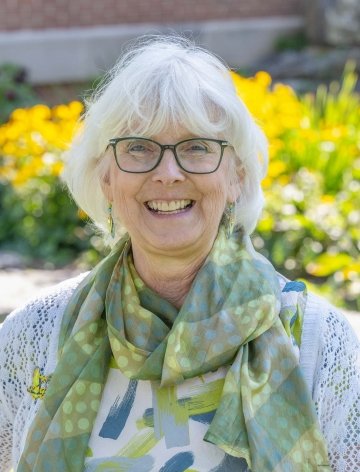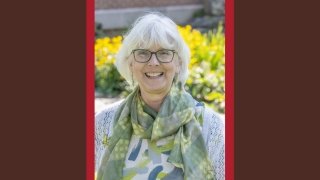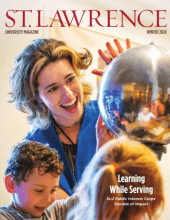Meet the Trailblazing Leader of Our New Center for the Environment
Diane White Husic, the inaugural Dick ’64 and Gail Stradling Executive Director of the Center for the Environment, is a seasoned environmental advocate, teacher, and researcher widely respected in her field.
In November, Diane shared her expertise at the 29th Conference of the Parties (COP29) as a board member of the Scientific Council of COP29 Presidency.

COP29 is a crucial international event where nations come together to discuss and negotiate measures to combat climate change and its impacts. Diane has attended the United Nations climate meetings since 2009, and she serves on the steering committee for the Research and Independent NGOs (RINGOS) constituency group and on a variety of task forces for the Technology Executive Committee that examines policy and best practices for mitigations and adaptation to climate change. Her insights and guidance will help shape the scientific agenda and ensure the success of this important COP29 event.
As Diane shapes the vision for the Center for the Environment—from guiding students on transformative educational experiences to fostering collaborations that bridge science, sustainability, and community engagement—one thing is clear: the Center will not only serve as a hub for academic inquiry but also as a catalyst for meaningful environmental action. The new center will amplify decades of campus conservation activities while encouraging all students, regardless of major, to see how environmental challenges intersect with their passions and academic pursuits.
Here, in her own words, she shares a bit about her background and what inspires her to do this work.
Nature was always a significant part of life in the Upper Peninsula of Michigan, where I grew up. Everyone forages, hunts, and/or goes fishing, and most people have a camp on a lake, which is not unlike the North Country. I was fortunate to have several pivotal environmental education experiences in middle and high school and worked at summer camps, so I spent a lot of time outdoors when I was young.
My environmental career began to crystallize while I was working at a contaminated site on the Appalachian Ridge in Pennsylvania. I was teaching at Moravian College (now University), where, as part of an NSF grant, my collaborators and I were trying to get more students interested in plant science. Despite being a group of molecular lab scientists, we took a cohort of summer research students into the field to learn about revegetation efforts and phytoremediation. My students and I ended up working on the area designated by the Environmental Protection Agency as a Superfund site, one of the most contaminated sites in the country. Initially, I didn’t know much about the site’s history, but once we discovered the extent of contamination and became involved in the collaborative efforts to rehabilitate the landscape—then to see it ultimately become a thriving and biodiverse grassland that now serves as wildlife refuge—that was a transformative experience for me, and I think for all of us.
I always tell new college students to stay open to exploring new paths. Many students don't initially see themselves as interested in the “environment,” but when we’re able to connect these issues to their interests in things like art, writing, social justice, mental health, and general wellness, we can invite them into the conversation and work. I love that the Center for the Environment gives us the opportunity to expand the definition of environmental studies.
As a leader, you never know where you’ll find inspiration. There was a local retired high school teacher and avid birder who I had the pleasure of working alongside on the Appalachian site. One of his favorite sayings was “We were confronted by insurmountable opportunities!” I loved his infectious optimism and ability to think about overwhelming challenges in new ways. His approach wasn’t just inspiring–it was effective.
Nobel Peace Prize-Winner Wangari Maathai, the late environmentalist and activist from Kenya, is proof of the impact connecting people to their surroundings can have. She mobilized women in a grassroots effort to plant trees, effectively linking environmental restoration with women's empowerment and peace. She continues to be a source of inspiration to me, and I feel fortunate to have had the opportunity to learn from her through the U.N. climate meetings.
As a mom to two sons, both in their 20s and very interested in environmental issues, I’m also inspired by their concern for the future and the world they will inherit. They are my personal motivation to help ensure that we leave a better environment for future generations.
I’m discovering more and more each day what a special place St. Lawrence is. The trails, the trees, the Adirondacks, the rivers—I am drawn to its natural beauty. Connecting students to “place” is crucial for their learning and helps foster responsibility toward their environment.
I will serve as the connector for the incredible initiatives already in place, as well as the new ones we will build. The Center is our hub for academic programs, co-curricular opportunities, and community partners both near and far. In the short time I have been on campus, I have felt energized and excited by the input and collaborative spirit from partners across campus who have been immersed in this work. We will keep pushing for new ways to make the environmental learning experience tangible and personal for students, regardless of their major.
Coming into an endowed position is such a gift. I’m so grateful for the generosity of Dick and Gail Stradling who believe so strongly in the Center. I’ve also received dozens of emails, text messages, and phone calls from alumni, and others from the North Country, sharing their congratulations, ideas, and connections with other people and resources that could benefit the Center. I’m starting to understand firsthand the power and depth of the famous St. Lawrence alumni network. You can be sure there will be plenty of opportunities for Laurentians past and present to get involved.





